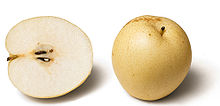he
pear is any of several tree and shrub species of genus
Pyrus (
 /ˈpaɪrəs/
/ˈpaɪrəs/), in the family Rosaceae. It is also the name of the pomaceous
fruit of these trees. Several species of pear are valued by humans for
their edible fruit, while others are cultivated as ornamental trees. The
genus
Pyrus is classified in subtribe Pyrinae within tribe Pyreae.
Etymology
The English word “pear” is probably from Common West Germanic
pera, probably a loanword of Vulgar Latin
pira, the plural of
pirum, akin to Greek ἄπιος
apios (from Mycenaean
ápisos), which is likely of Semitic origin.
[citation needed] The place name
Perry and
Pharisoulopol
can indicate the historical presence of pear trees. The term "pyriform"
is sometimes used to describe something which is "pear-shaped".
Description

Many varieties, such as the Nashi pear, are not "pear-shaped"
The pear is native
to coastal and mildly temperate regions of the Old World, from western
Europe and north Africa east right across Asia. It is a medium-sized
tree, reaching 10–17 m tall, often with a tall, narrow crown; a few
species are shrubby. The leaves
are alternately arranged, simple, 2–12 cm long, glossy green on some
species, densely silvery-hairy in some others; leaf shape varies from
broad oval to narrow lanceolate. Most pears are deciduous, but one or two species in southeast Asia are evergreen.
Most are cold-hardy, withstanding temperatures between −25 °C and −40
°C in winter, except for the evergreen species, which only tolerate
temperatures down to about −15 °C. The flowers are white, rarely tinted yellow or pink, 2–4 cm diameter, and have five petals.
[2] Like that of the related apple, the pear fruit is a pome,
in most wild species 1–4 cm diameter, but in some cultivated forms up
to 18 cm long and 8 cm broad; the shape varies in most species from
oblate or globose, to the classic pyriform 'pear-shape' of the European pear with an elongated basal portion and a bulbous end.
The fruit is composed of the receptacle or upper end of the flower-stalk (the so-called calyx tube) greatly dilated. Enclosed within its cellular flesh is the true fruit: five cartilaginous carpels, known colloquially as the "core". From the upper rim of the receptacle are given off the five sepals
[vague], the five petals, and the very numerous stamens.
Pears and apples cannot always be distinguished by the form of the
fruit; some pears look very much like some apples. One major difference
is that the flesh of pear fruit contains stone cells (also called "grit").

Tidak ada komentar:
Posting Komentar